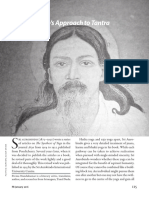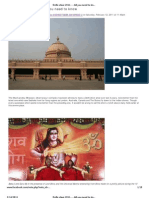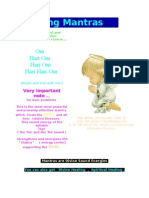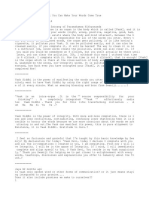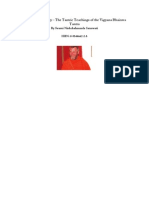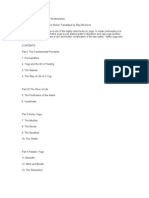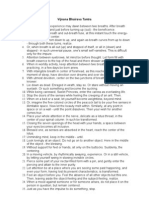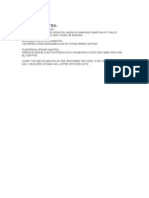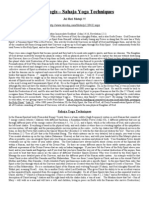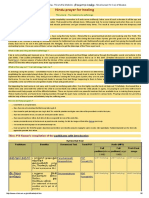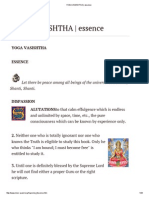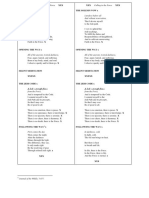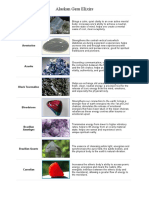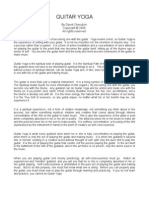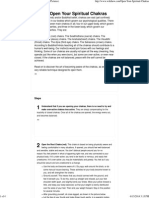0 ratings0% found this document useful (0 votes)
117 viewsThe Gorakhbodha
The Gorakhbodha
Uploaded by
Jacob BargerThe document contains a dialogue between Gorakhnath and Guru Matsyendranath where Gorakhnath asks a series of questions and Matsyendranath provides concise responses. Some key points discussed include:
- The ideal for a disciple is to renounce desire, cruelty, greed, delusion and live simply with little food or sleep.
- A disciple should see the self, contemplate the endless, and realize reality as the essence through the Guru's teachings.
- The form of the mind is void, the appearance of breath is invisibility, and control is through the tenth door.
- Mind is the root and breath is the branch, while
Copyright:
© All Rights Reserved
Available Formats
Download as DOCX, PDF, TXT or read online from Scribd
The Gorakhbodha
The Gorakhbodha
Uploaded by
Jacob Barger0 ratings0% found this document useful (0 votes)
117 views11 pagesThe document contains a dialogue between Gorakhnath and Guru Matsyendranath where Gorakhnath asks a series of questions and Matsyendranath provides concise responses. Some key points discussed include:
- The ideal for a disciple is to renounce desire, cruelty, greed, delusion and live simply with little food or sleep.
- A disciple should see the self, contemplate the endless, and realize reality as the essence through the Guru's teachings.
- The form of the mind is void, the appearance of breath is invisibility, and control is through the tenth door.
- Mind is the root and breath is the branch, while
Original Description:
Gorakhbodha written by Guru Goraksha. A must have for every yogi.
Copyright
© © All Rights Reserved
Available Formats
DOCX, PDF, TXT or read online from Scribd
Share this document
Did you find this document useful?
Is this content inappropriate?
The document contains a dialogue between Gorakhnath and Guru Matsyendranath where Gorakhnath asks a series of questions and Matsyendranath provides concise responses. Some key points discussed include:
- The ideal for a disciple is to renounce desire, cruelty, greed, delusion and live simply with little food or sleep.
- A disciple should see the self, contemplate the endless, and realize reality as the essence through the Guru's teachings.
- The form of the mind is void, the appearance of breath is invisibility, and control is through the tenth door.
- Mind is the root and breath is the branch, while
Copyright:
© All Rights Reserved
Available Formats
Download as DOCX, PDF, TXT or read online from Scribd
Download as docx, pdf, or txt
0 ratings0% found this document useful (0 votes)
117 views11 pagesThe Gorakhbodha
The Gorakhbodha
Uploaded by
Jacob BargerThe document contains a dialogue between Gorakhnath and Guru Matsyendranath where Gorakhnath asks a series of questions and Matsyendranath provides concise responses. Some key points discussed include:
- The ideal for a disciple is to renounce desire, cruelty, greed, delusion and live simply with little food or sleep.
- A disciple should see the self, contemplate the endless, and realize reality as the essence through the Guru's teachings.
- The form of the mind is void, the appearance of breath is invisibility, and control is through the tenth door.
- Mind is the root and breath is the branch, while
Copyright:
© All Rights Reserved
Available Formats
Download as DOCX, PDF, TXT or read online from Scribd
Download as docx, pdf, or txt
You are on page 1of 11
The Gorakhbodha
Questions from Gorakhnath to Guru Matsyendranath
Gorakh: -- O Lord (Swami), you are the Master Teacher (Satguru Gosain), and I am but a
disciple: may I put a question, which you would kindly reply to and resent not? To start
with, what ideal (lacch) should the disciple put before him? Do tell me for you are the true
Teacher.
Macchendra: -- Let the unattached (avadhut, avadhuta) live at the monastery (hat) or be on the
road, resting in the shadow of the trees; he should renounce desire, cruelty, greed, delusion, and
the illusion of Samsara (Kama, Krodha, Lobha, Moha and Samsar ki Maya); he should hold
converse (gosht) with himself and contemplate the Endless (Ananta); he should sleep little and
eat little. In the beginning the disciple should live thus. Thus speaks Macchendra. [2]
Gorakh: What should he see, contemplate, treat as the essence (sar); with what should he
shave his head and with the knowledge of what should he try to cross (the ocean of
Samsara)?
Macchendra: He should see himself, contemplate the Endless (Ananta), and fix upon Reality as
the essence; he should shave his head with (or after receiving) the word of the teacher (Guru Ka
Shabda), and should cross over with the aid of Divine knowledge (Brahma Gyana). [4]
Gorakh: What is the teaching (upadesh) of the Guru's order or doctrine (Adesh)? Where
does the void (Sunya) reside? Who is the Guru of the word (Shabda)?
Macchendra: The most wonderful (anupam) is the teaching of the Guru (Adesh); the void
(Sunya) resides within us and Realization (parcha or parichaya) is the Guru of the word (shabda).
[6]
Gorakh: What is the form (rupa) of the mind (mana)? What is the appearance (akara) of
the vital breath (pavana)? What is the direction (disa) of the ten and through which door
can the control be affected?
Macchendra: The void (sunya) is the fore of the mind; the appearance of vital breath (pavana) is
invisibility (nirakara); the direction of the ten is unsayable (alekh) and control lies through the
tenth door. [8]
Gorakh: Which is the root (mula) and which the branch (bela)? Who is the Guru and who
the disciple; with what essence (tat) can one go about alone?
Macchendra: Mind is the root and vital breath is the branch; the word (shabda) is the Guru and
attention (surat or surta) is the disciple. With the essence called deliverance (nirvana tat)
Gorakhnath wanders about, himself in himself. [10]
Gorakh: What is the seed (biraja) and what the field (kshetra)? What is direct hearing
(satvan)? What is true vision? What is Yoga and what is the method (Yugti)? What is
liberation (mocch)? And what is salvation (mukti)?
Macchendra: The word (Mantra) is the seed; perception (mati) is the womb or land; and attention
(surti) is direct hearing, and discrimination (nirti) is true vision; the ocean (Uram) is Yoga and
the earth (Dhuram) is the method; light (joti) is liberation and the refulgence (Juala) is salvation.
[12]
Gorakh: Which is the tree without trunk, and which is the parrot without wings? Which is
the dam (palu) without a shore (tir), and who died without death (kal)?
Macchendra: Vital breath (pavana) is the tree without a trunk; mind is the parrot (sua) without
wings; constancy (dhiraj) is the dam without a shore; sleep is dying without death. [14]
Gorakh: In what house (ghar) is moon (chanda) and in what is the sun (sur)? In what
house does Time play music (Tur, a musical instrument)? Where do the five elements (tat)
have equipoise (sam rahai)?
Macchendra: The moon in the mind; the sun in the vital breath; in the void (sunya) Time plays
on the musical instrument (tura) and in the house of knowledge the five elements reside in
equipoise (sam). [16]
Gorakh: What is the New Moon (amavas) and what manifests (pariba)? Which or where is
the great elixir (maha rasa) and whereto with it do we mount? At what place does the mind
reside in the state of self-transcendence (unmani)?
Macchendra: The sun (ravi) should be treated as the darkest night; the moon should be made
manifest; the great elixir of the lower (ardh) should be taken to the upper (urdh); in the heaven
within us (gagan) the mind resides in self-transcendence. [18]
Gorakh: What destroys the bad word (kusabda) and where does the good word (susabda)
reside? On what side (mukha) does the vital breath of twelve fingerbreadths reside?
Macchendra: The good word swallows or catches the bad word and itself resides within
(nirantar); the vital breath of twelve fingerbreadths is controlled (rahai) through the word of the
Guru. [20]
Gorakh: Who is the Adiguru? Who is the husband of the earth (dhartri)? What is the
home of knowledge (gyana)? Which is the door (duvar) of the void (sunn)?
Macchendra: The eternal beginningless (anadi) is the Adiguru; heaven (anbar) is the husband of
earth; Awake-awareness (Chetan) is the home of knowledge, and realization (parcha) is the door
of the void. [22]
Gorakh: Through the realization (parchai) of what is the attachment with the Illusion
(maya moha) broken; how can the residence of the moon (Sisihar) be pierced; how is the
dam (bandha) applied and how can the body (kandha) be made immortal (ajar var)?
Macchendra: When realization (parchai) comes to the mind, attachment to the world ceases; with
the control of the working of vital breath the moon(sisihar) is destroyed; the acquisition of real
knowledge (gyana)applies the dam and the realization of the teacher (Guru parchai) gives us
immortality. [24]
Gorakh: Where do mind, vital breath, the word (shabda) and the moon reside?
Macchendra: The mind resides in the heart (hirdai); vital breath resides in the navel; the word
(shabda) resides in the will (ruci); the moon resides in the heaven (gagan). [25]
Gorakh: If there had been no heart (hirda) where would the mind have rested, composed?
Had there been no navel where, would have vital breath rested unmoved? Had there been
no form (rupa) where would have the word (Shabda} resided? Without a heaven where
would have the moon been?
Macchendra: Without the navel, the air would have resided in the formless (Nirakar); without
will, the word (shabda) would have resided (rahata) in the unmanifest (Akula); without the
heaven, the moon would have resided in desire (abhika).
Gorakh: Had there been no night, where would the day have come from? Without the day,
where would the night merge? When the lamp is extinguished, where does light dwell?
Macchendra: Without night, the day would have merged into Sahaj; had there been no day, the
night would have passed into (Sahaj); on the extinguishing of the lamp, the light passes into the
omnipresent (nirantar); had there been no vital breath, then the body of vital breath (prana
purusha) would have resided in the void. [30]
Gorakh: Who is the creator of the body (kaya); wherefrom has light (tej) been created?
What is the mouth (muha/muda) of Divine knowledge (Brahma Gyana)? How can the
Unseeable be seen?
Macchendra: The Absolute (Brahma) is the creator of the body (kaya); out of truth (sat) has
effulgence (tej)been created; the void is the mouth (muda or muha) of Divine
knowledge(Brahma Gyana); and through the Sadguru and the disciples realization may the
unseeable be made visible. [ 32]
Gorakh: How many lakhs (hundreds of thousands) of moons are there in the body? How
does fragrance reside in the flower? Where does the ghee hide in the milk? How does the
soul (jiva) conceal itself in the body?
Macchendra: There are two lakhs of moons in the body; fragrance is the conscious(ness) (chetan)
in the flower; the ghee is immanent in the milk; the soul (jiva) is the all- pervasiveness in the
body. [34]
Gorakh: Had there been no body where would the sun and the moon have resided? Had
there been no flower, where would the fragrance have been? Had there been no milk where
would the ghee have been? Had there been nobody, where would the spirit have been?
Macchendra: Without the body, the sun and the moon would have been omnipresent; without the
flower, fragrance would have dwelt in the (Anhad); without the milk, the ghee would have
resided in the void; without the body, the spirit would have been in the Supreme Void
(ParamSunn). [36]
Gorakh: Where do the moon and the sun dwell, where the essence, the root of the word
(nad) and the vital power (bind)? Where does the Hamsa (swan) mount up for drinking
water? To what place (ghar) do you bring the reversed power (ulti shakti) to rest?
Macchendra: The moon resides in the upper (urdha) and the sun in the lower (ardha); the
essence, the nada and bindu dwells in the heart; to the heaven goes the swan (hans) for drinking
water, and the reversed power(Shakti) reverts to the Self, its real, original home. [38]
Gorakh: Where does nada rise; where does it acquire equipoise (sam); how is it made to
stand still, and where is it finally merged?
Macchendra: Nada rises from the Unconditioned (Avigata); gains equipoise in the void; you can
stop it through the vital breath and it vanishes, unites with the Formless (Niranjana). [40]
Gorakh: If the nada sounds not, if the power acts not, if the heaven is not there to draw our
hope, were there neither nada nor bindu, then where would the man of vital breath (Prana
Purusha) reside?
Macchendra: Nada sounds, bindu moves; the heaven (gagan) attracts desire; but were there
neither nada nor bindu, then breath would reside in the omnipresent (nirantar). [42]
Gorakh: When form dissolves and the Formless remains, when water becomes air, when
there is neithersun nor moon, where does the Hamsa dwell?
Macchendra: TheSahaja hans(a) resides after the play in the Person of the void (Sunnhans); when
the form becomes Formless then the spirit (hans) resides inthe Supreme light (Param Joti). [44]
Gorakh: What is the root (mula) of the rootless (Amul)? Where does the root reside? Who
is the Guru of the goal (pada)?
Macchendra:The void is the root of the rootless; the root resides in theomnipresent (Nirankar);
the Guru of the goal is liberation (Nirban).[46]
Gorakh: Where does the vital breath (prana) rise?Wherefrom does the mind come? How is
the speech (vacha) born and wheredoes it dissolve (viliyate)?
Macchendra: The birth of themind is from the Formless (Avagat), the vital breath from the mind,
andspeech from the breath; speech is dissolved in the mind. [48]
Gorakh: Which is the lake and which the lotus? How can we ward off Kal(time ordeath)?
How can we reach the Unseeable, Unreachable (Agochar) world?
Macchendra: Mind is the lake and air is the lotus; by becoming upwards-faced(Urdh-mukhi) you
can ward off Kal; through knowing the lower and theupper one my become one with the
Unknowable (Agochar liv lahai). [50]
Gorakh: Which is the difficult, and which the easy; what is union (sandh), andthrough
what nerve centre (chakra) can the moon be made stable? How canthe conscious mind
attain to self-transcendence?
Macchendra:The Pure (Anila) and the Stainless (Vimal) are the difficult and easyforms of union
(sandh); the dam is to be applied above the chakinerve-centre (chakra); the always-awake can
attain toself-transcendence (unmani). [52]
Gorakh: How came about birth? How did the first consciousness begin (ad ki surat)? How
was I born?
Macchendra:As oil is in the sesame seed, as fire is in the wood, as fragrance inthe flower, so too
resides the spirit (devata) in the body (deh). [54]
Gorakh:What drives ahead the conch-like (sankhini)? Where does the elixir inthe arched
vein (banka nala) go? As the breather goes to sleep, wheredoes the vital breath (prana) in
the body (pinda) side?
Macchendra:True spontaneity (sahaj subhai) can drive the conch-like (sankhini);the arched vein
(banka nala) resides in the navel; as the breather goesto sleep; the vital breath in the body resides
in its own shadow orresides undivided (api chhaya or aparchhinna). [56]
Gorakh:At what nerve centre (chakra) is the moon stabilised? At what nervecentre
(chakra) is the union or penetration (sandh) applied? What nervecentre (chakra) controls
(niredha) the vital air? What centre (chakra)imparts knowledge (pramodh) to the mind?
At what centre (chakra) shouldattention (dhyana) he centred (dhariye)? At what centre
(chakra) shouldone rest?
Macchendra: The higher (Urdh chakra), the lower(Ardh chakra), the Pashchima (west) centre,
the heart centre, thethroat (kantha) centre the Gyana (Agya) chakra.
Gorakh: Which is the garden, the town and the mandal? In which city is the Guru? If I
forget it, how am I to cross over?
Macchendra:Whoso gives up speech has achieved the void of the manifoldness (mayasunn): in
contemplating that, one rises above good and evil; by anunderstanding of Shiva and Shakti, one
may attain to self-transcendence(unmani). [60]
Gorakh: By what stalk of the lotus (nala)can the liquid (Siva) be drawn up? How does the
soul (jiva) drink it?How can one residing in the womb of the mother, drink the elixir?
Macchendra:It is collected through the Shankhini Nadi; the soul (jiva) resides inthe Sushumna
nadi; while residing in the womb of the mother he drinksit through the banka nala. [62]
Gorakh: What is the house(graha) and what the habitation; in what womb does he remain
for tenmonths? Through what mouth does he drink water and through what mouth,milk?
In what direction was the body born?
Macchendra:The Pure, the Formless (Anil) is the house (graha) and theUnconditioned (avagat),
the habitation (has); in the womb of the Beyond(Atit) he remains for ten months; through mind
he has water and throughvital air (pavan) he drinks elixir or milk (amrit); in the direction
ofOmkar the body takes birth.
Gorakh: In what void (sunn) is he born? In what void (sunn) is he absorbed?
Macchendra:He is born in the Sahaja Void and the Satguru gave him instruction atthe void of
nearness (Samip Sunn); he then got absorbed in the void ofunattachment (Atit Sunn). He then
explains to you the essence of thesupreme void (Param Sunna). [88]
Gorakh: How can oneattain to Samadhi? How can one get rid of the disturbing
factors(upadhi)? How can one enter the fourth (Turiya) state? How can one makeone's
body (kandh) changeless and deathless?
Macchendra:The young person (bala) enters Samadhi through the mind; he gets rid ofthe
disturbances through the vital breath (pavan); he acquires thefourth state (Turiya) through
attention (surat) or realisation (Gyana)and through obeying, turning to, the Guru (Guru mukh) he
attains toimmortality. [68]
Gorakh: Who sleeps, who wakes, who goesto the ten directions? Wherefrom does the vital
breath arise? How doesit bring sound from the lips, throat and the palate (talika or
taluka)?
Macchendra:The mind, or the absorbed (liv) sleeps; the vital breath or theconscious (chetan)
awakes; imagination (kalpana) goes out to the tendirections. From the navel the air arises, it rises
and produces soundsfrom the lips, throat and the palate (taluka). [70]
Gorakh:What is the conscious? What is the essence (sar)? What is sleep andwhat is death?
By realising what (parchai) does one sustain theelements (tat)?
Macchendra: The light (Joti) isconscious; fearlessness is the awakened essence. Waking is birth
andsleeping is death; the five elements dwell in light. [72]
Gorakh: Who speaks, who sleeps; in what form does he seek himself? In what form does he
remain the same through the ages?
Macchendra:Word (shabda) speaks; attention (surat) sleeps; he seeks himself in anUnseeable
(adekh) form and in the Form without Form he remains the samethrough ages. [ 74 ]
Gorakh: How does the mind acquirevirtues? How does the vital air come and go? How
does the fountain(nihjar) rise from the moon and how does Time or Death (kal) go tosleep?
Macchendra: In the heart (hirdai) the mindacquires the many virtues; in the navel the vital air
starts its comingand going (Avagavan); contemplating itself (apmukhi) he makes thefountain
play; contemplating itself Time or Death goes to sleep. [76]
Gorakh:At which void (sunn) does light reverse; from which void does speecharise; which
void is the essence of the three worlds; through whichvoid can one cross over?
Macchendra: The void ofeagerness, the void of fearlessness, the void of self-mastery, and
thevoid of detachment. (Urga, Anbhai, Prabhu, Atit). [78]
Gorakh: Where does hunger arise and where food? Where is sleep born and where death?
Macchendra: From desire (mansa) arose hunger and from hunger, food; from food sleep and
from sleep, death. [80]
Gorakh:At which lotus does the Hamsa (hans) inhale and exhale (sas, usas); atwhich lotus
does Hamsa rest; at what lotus does he perform worship(puja) and at what lotus does he
see the Unseeable (Alakh)?
Macchendra: The navel lotus, the heart lotus, the centre (madh) lotus, the lotus Beyond (Achint).
[82]
Gorakh:What is truth? Do tell me, please, O Guru Pandit. What is the conditionor
direction of the mind and the breath? How can one swim across (theocean of Samsara)
with their help?
Macchendra: Progressionfrom mere seeing, to divine or spiritual perception (dibya drisht);from
knowledge (gyana) towards realisation (vigyma); the teacher andthe pupil have the same body; if
realisation (parcha) comes, then therewill he no straying or return. [84]
Gorakh: Wherefrom doinhalation and exhalation arise? Where does the Param Hans
reside? Atwhat place does the mind reside constantly stable?
Macchendra:They rise from the lower (Ardh); at the higher (Urdh) the Supreme Swan(Param
hans) resides; in the Sahaja Void the mind is ever in equipoise.In the realisation of the word
(Shabda parchai) the mind remains inequipoise. [86]
Gorakh: How should one come, how go; how to collect oneself and remain absorbed; how
can one stabilise one's mind and one's body?
Macchendra:He should come and go in the void and in the void (sunn) he shouldcollect himself
and remain absorbed; in the Sahaja Void the body andthe mind remain unchanged. [ 88 ]
Gorakh: Where doesShiva reside and where Shakti? Where resides vital breath (prana)
andwhere the embodied being ( Jiva) ? At what place can one have therealisation of them?
Macchendra: At the lower (Ardh)resides Shakti and at the higher (Urdh) Shiva; inside resides
vital breath (prana) and further inside the embodied being (Jiva); by goingstill further in, one
may attain to a realisation of them. [90]
Gorakh: How should one sit and how walk, how speak and how meet; how should one deal
with one ' s body?
Macchendra:He should sit, walk, speak and meet awake and aware (surat mukh); withhis
attention and discrimination (surat or nirat) thus handled, heshould live fearlessly. [92]
Gorakh: What is the word(shabda); what is attention (supat); what is discrimination
(nirat)?What is the dam? How can one remain stable amidst duality?
Macchendra:The Beginningless, the Soundless (Anahad) is the word; right awarenessis attention
(surat); independence (niralanb) is discrimination(nirat); let him apply the check; he will then
live as Unity amidstDuality. [94]
Gorakh: Who can tread a path without feet? Who can see without eyes? Who can hear
without ears? Who can speak without words?
Macchendra:Contemplation (vichar) can tread without feet; discrimination (nirat)can see without
eyes; attention (supat) can hear without ears; theSoundless (Anhad) can speak without words.
[96]
Gorakh: Which posture (asan)? What knowledge (gyana)? How should the youngdisciple
(bala) meditate (dhyan)? By what means can he enjoy the blissof the Unconditioned Being
(Avagata)?
Macchendra:Contentment (santokh) is the posture (asana); contemplation is theknowledge
(gyana); he should try to rise above his physical being in(or for) his meditation; through carrying
out the behest of the Guru hecan have the joy of the Unconditioned Being (Avagata). [98]
Gorakh: How to have contentment and contemplation and meditation that goes beyond the
physical? How can I bend my mind to them?
Macchendra:Contentment comes from fearlessness (nirbhai); thinking from avoidanceof
attachment or realisation (anbhai); he should meditate within hisbody to rise above the body; by
turning to the Teacher (Guru) one canbend one's mind to them. [100]
Gorakh: What is thecleansing (Dhoti)? What is conduct (Achar)? Through what
recitation(Japa) does the mind come to rid itself of restless thoughts (Vikaras)?How can
one become unattached and fearless?
Macchendra:Meditation is purification; right thinking, discrimination leads toright action;
through the Ajapa Japa ( = Ha Sa) the mind rids itself ofrestless thoughts; by becoming
unattached one can become fearless. [102]
Gorakh: Who is the Omkar and who is the Self (ap); who is the mother and who is the
father? How can the river (darya) enter the mind?
Macchendra:The word (Shabda) is the One (Omkar); light (Joti) is the Self; thevoid (Sunn,
Surat) is the mother and consciousness (Chit or Chaitan) is the father; steadiness (nishchai --
without anxiety) causes the riverto flow in the mind. [ 104 ]
Gorakh: How can one carryout true living (rahini) and how can one carry on meditation?
Where is the immortal elixir? How can one drink it? How can one keep the bodyfor ever?
Macchendra: By turning to the higher (Urdha) orthe mind, you can attain right living; by turning
to Shakti you canachieve right meditation; by turning to the heaven within (gagan) youcan have
the elixir of immortality (Amirasa) and by turning toconscious activity (chit) you can drink it. By
relinquishing desire,one can gain the immortal body (bidehi rahai). [106]
Gorakh: How should one come and go; how can one defeat death? How can one reside in
light?
Macchendra:One should turn to Sahaja; one should go by turning to Shakti; bybecoming
wingless one can eat away death; one can always reside inlight by being without breath
(niswasa). [ 108]
Gorakh: What is body, what is breath; what Person (purukh) should I meditate upon? At
what place does mind transcend Time?
Macchendra:Air is the body and the mind is the breath (force); we should meditateon the
Supreme Person (Param Purukh). In Samadhi the mind goes beyondthe reach of Time. [110]
Gorakh: Which is the key and which is the lock; who is old and who is young (bala)?
Where does mind remain awakened (chetan)?
Macchendra:The wordless (nih-shabda) is the key and the word (shabda) is the lock;the
unconscious one (achet) is old; the conscious one is young; mind inself- transcendence (unman)
is ever aware (chetan). [112]
Gorakh:Who is the practitioner (sadhak) and who the perfected (Siddh)? What isillusion
and what is magic? How can one drive away deception from one'smind?
Macchendra: Attention is the practitioner and theword is the adept; "I am" is the illusion (Maya)
and "he is" is themagic (riddh). To destroy deception or duality one should residewithin. [114]
Gorakh: Which is the mould, and which is the calx of tin? Which is the ornament and how
may it be beautified?How should self-transcendence (unmani) reside changeless with that?
Macchendra:Knowledge (gyana) is the mould; vital breath is the calx (beng); lightis the
ornament which makes it beautiful; self-transcendence (unmani)should reside with That
steadfastly, unchangingly. [116]
Gorakh: Which is the temple and who is the god (deva); how to worship it? How should
one reside there with the five unholy ones?
Macchendra:The void is the temple; mind is the god; one should serve Him by beingwithin
(nirantar); with the five one should reside in self-transcendence (Unman). [ 118]
Gorakh: Which is thetemple, which the door; which is the image and who is the
Unfathomable(Apar)? By what method of worship can the mind transcend itself
(Unmanrahai)?
Macchendra: The void is the temple; Shabda is thedoor; Light is the image; the Flame (Jvala) is
the Unfathomable (Apar);through turning to the form of the Formless (Arupa) or to the Guru
onecan reside self-transcendent, or fathom the secrets. [120]
Gorakh: Which is the lamp and which is the light? What is the wick wherein the oil
resides? How can the lamp be made inextinguishable?
Macchendra:Knowledge (Gyana) is the lamp; the word (shabda) is the light(prakash);
contentment (santokh -- santosha) is the wick in which theoil resides; one should destroy duality
and be without partiality(akhandit). [122]
Gorakh: What goes slow and what goes fast? Who revolves and what is the find? In what
place can one be fearless?
Macchendra:Steadiness of mind (dhiraj) goes slow; restless thought (vikara) goesfast; surat
(attention) revolves (phurti) and truth (sar) is the find.[124]
Gorakh: Who is a Yogi? How should he live inequipoise? Who is an enjoyer (Bhogi) and
how should he acquire? Howdoes pain rise out of pleasure and how can one patiently suffer
pain?
Macchendra: Mind is the Jogi; let him live in self-transcendence; the great elixirwill come to him
and he will enjoy all pleasures; in that elixir is theindivisible (akhandit) pain; the word (shabda)
of the Guru secures thepatience to suffer it. [126]
Gorakh: Which is the self(Atma), what comes and goes? Which is the self, what is absorbed
in thevoid? What is the self, what stays changeless in the three worlds? Byknowing whom
can one become one of the fifty-two heroes (bavan bir)?
Macchendra:The self of vital breath (pavan atma) comes and goes; the mind-self isabsorbed in
the void; the knowledge-self resides unchanged in the threeworlds; by knowing (parchai) the
Guru one becomes one of the fifty-twoheroes. [128]
Gorakh: What is the life (Jiva) of themind? What is the support (besas) of that life (jiva)?
What is thebasis of that support? What is the form of the Brahma?
Macchendra:The life (jiva) of the mind is the vital air and the support of theembodied being
(jiva) is the void; the basis (adhar) of that support(besas) is the form of Brahma (= Absolute);
and the form of the Brahmais unthinkable (Achintya). [130]
Gorakh: Through whichcentre can one make one's body immortal? Through which centre
can oneattain to the Unknowable dam (Agochar bandh)? Through which centre canthe
Hamsa be liberated (Hans nirodh)? Through which centre can the mindbe instructed?
Which centre gives pleasure? Which centre brings on theSamadhi?
Macchendra: The anus (Mula) centre; the penis(Guda) centre; the navel (Nabhi) centre; the heart
centre; the throatcentre and the head (Nilata) centre. He who knows the meaning of thesesix
chakras, he is the Cause, he the Deva. [132]
He is a Yogiwho controls (sadhita) the mind and the vital air (pavana); he is notstained by
evil. He is not seized of merit. [133]
You might also like
- Siddha Yoga BooksDocument7 pagesSiddha Yoga BooksR K ShrivastavaNo ratings yet
- Egyptian Sexual Energy and The OrgasmDocument1 pageEgyptian Sexual Energy and The OrgasmAnonymous DfeajF100% (1)
- Shamanic Empowerment ManualDocument27 pagesShamanic Empowerment ManualAlbano FcBayernNo ratings yet
- Energetic SeductionDocument13 pagesEnergetic SeductionAdana Washington90% (31)
- Gamaka Box Notation OverviewDocument3 pagesGamaka Box Notation OverviewjjrrcwNo ratings yet
- Social Justice Through The ChakrasDocument35 pagesSocial Justice Through The ChakrasRivkaWillowNo ratings yet
- Aromatherapy: Biblical Path To Healing or Demonic Deception? by Chuck & Julie CohenDocument33 pagesAromatherapy: Biblical Path To Healing or Demonic Deception? by Chuck & Julie CohenChristine Pack79% (19)
- Reiki Level 3 Master Manual Peggy JentoftDocument45 pagesReiki Level 3 Master Manual Peggy JentoftSneza NanaNo ratings yet
- Gomati ChakraDocument2 pagesGomati ChakraGautamsabooNo ratings yet
- Metaphysical and Healing Properties of GemstonesDocument89 pagesMetaphysical and Healing Properties of Gemstonessunni (aamil) spiritual healer100% (4)
- Chakras Book PDFDocument89 pagesChakras Book PDFAA100% (15)
- SwarodayaDocument34 pagesSwarodayaAnurag AnupamNo ratings yet
- 9 Sri AurobindoDocument11 pages9 Sri AurobindoTukaram ChinchanikarNo ratings yet
- Analysis and Meaning of Samvatsari Pratikraman: Anop R. Vora Rochester, NYDocument46 pagesAnalysis and Meaning of Samvatsari Pratikraman: Anop R. Vora Rochester, NYgaurav112011No ratings yet
- An Overview of Breathing Exercise (Vasiyogam) in Siddha Concept-A Literature ReviewDocument11 pagesAn Overview of Breathing Exercise (Vasiyogam) in Siddha Concept-A Literature ReviewLAKSHMI NARAYANAN R SNo ratings yet
- Mystical Mantras MagicalDocument2 pagesMystical Mantras Magicalgvsha88No ratings yet
- Kriya Yoga 2.0Document2 pagesKriya Yoga 2.0amitlkoyogaNo ratings yet
- Yogini TempleDocument59 pagesYogini TempleAjay J. VERMA100% (1)
- Delhi Shivir 2011 - All You Need To Know - FacebookDocument19 pagesDelhi Shivir 2011 - All You Need To Know - Facebookamit9338No ratings yet
- Babaji in LondonDocument15 pagesBabaji in LondonParama Saha100% (1)
- About Golden Reiki Ray Shoba ParameshwaranDocument3 pagesAbout Golden Reiki Ray Shoba ParameshwaranShoba PNo ratings yet
- Holy MantraDocument4 pagesHoly Mantrabutterbeer_88100% (1)
- Shivyog Kriyas - Part 1: Avdhoot Baba ShivanandjiDocument2 pagesShivyog Kriyas - Part 1: Avdhoot Baba Shivanandjiyuvraj333333100% (1)
- Gorakh Nath SaysDocument3 pagesGorakh Nath Saysamnotaname4522No ratings yet
- On Early RiseDocument14 pagesOn Early RiseArseniy Plagov100% (1)
- Healing MantrasDocument5 pagesHealing MantrasSargam RanaNo ratings yet
- The Power of Vaak Siddhi You Can Make Your Words Come TrueDocument2 pagesThe Power of Vaak Siddhi You Can Make Your Words Come Truesonaliforex1100% (1)
- Maha Kaalbhairav StotraDocument1 pageMaha Kaalbhairav StotraVedic Bhairav0% (1)
- Tantra and PurificationDocument2 pagesTantra and PurificationFranjo GrgićNo ratings yet
- Toh563 - 84000 Upholding The Great Secret MantraDocument30 pagesToh563 - 84000 Upholding The Great Secret MantraSergeyNo ratings yet
- 5 Shiva Shrines Leading To Mastery of The Elements - Yogini AshramDocument22 pages5 Shiva Shrines Leading To Mastery of The Elements - Yogini AshramkirushnenNo ratings yet
- Preview Insight Into RealityDocument15 pagesPreview Insight Into RealityronniecarletonNo ratings yet
- InitiationDocument2 pagesInitiationmukti banaNo ratings yet
- Meditation of Light ENG PDFDocument3 pagesMeditation of Light ENG PDFAdam BoNo ratings yet
- God RealisationDocument140 pagesGod RealisationRameshkumar Chandrasekaran100% (3)
- Hatha Yoga Pradeepika of SvatmaramaDocument2 pagesHatha Yoga Pradeepika of SvatmaramalathacoolNo ratings yet
- Short Tara SadhanaDocument2 pagesShort Tara SadhanaMadu. RajuNo ratings yet
- Durga 32 NamesDocument1 pageDurga 32 Namessayan biswasNo ratings yet
- Shiva SamhitaDocument27 pagesShiva SamhitaTheOneWhoGets0% (1)
- Vijnana Bhairava TantraDocument4 pagesVijnana Bhairava TantraSilivrianoneu NeuNo ratings yet
- (Self-Help To Get Relief From Black Magic) : You Must Eliminate The Following From Your LifestyleDocument4 pages(Self-Help To Get Relief From Black Magic) : You Must Eliminate The Following From Your LifestyleKanishkaNo ratings yet
- Analects of SWAMI SIVANANDA Completed BookDocument113 pagesAnalects of SWAMI SIVANANDA Completed BookKartik VashishtaNo ratings yet
- Wangdu PrayerDocument2 pagesWangdu PrayerGrant Gabriel100% (1)
- Chapter-9 Raja Yoga (Summary) : Guhyam (Royal Knowledge and Royal Secret) - This Knowledge Is Royal BecauseDocument1 pageChapter-9 Raja Yoga (Summary) : Guhyam (Royal Knowledge and Royal Secret) - This Knowledge Is Royal BecauseVikram Raj SinghNo ratings yet
- Mudra VignanamDocument5 pagesMudra Vignanam4partha100% (1)
- Apsara Mantra-: MONDAY, MARCH 1, 2010Document1 pageApsara Mantra-: MONDAY, MARCH 1, 2010Sonu JaiswalNo ratings yet
- Unbelievable Secrets - NaagmaniDocument3 pagesUnbelievable Secrets - Naagmanisonumonu23No ratings yet
- New Yogis - Sahaja Yoga TechniquesDocument6 pagesNew Yogis - Sahaja Yoga Techniquesapi-19974548100% (2)
- Gorakhvani en ExtractDocument16 pagesGorakhvani en ExtractKevinNo ratings yet
- Chinese Shamanic Cosmic Orbit Qigong: Master Zhongxian WuDocument1 pageChinese Shamanic Cosmic Orbit Qigong: Master Zhongxian WuYahuzaNo ratings yet
- Father of All The Buddhas - JamchenDocument16 pagesFather of All The Buddhas - JamchenalbertmelondiNo ratings yet
- Mantra ChantingDocument2 pagesMantra ChantingomkararesearchNo ratings yet
- Agya Chakra and Your PersonalityDocument7 pagesAgya Chakra and Your PersonalityDrGarima Saxena MehtaNo ratings yet
- Hindu Prayer for Healing - ThirumuRai Medicine - திருமுறை மருந்து - Miracle prayer for Cure of diseasesDocument6 pagesHindu Prayer for Healing - ThirumuRai Medicine - திருமுறை மருந்து - Miracle prayer for Cure of diseasesHi Moto TMNo ratings yet
- Aquarian Sadhana MantrasDocument8 pagesAquarian Sadhana MantrasMarkus van der WesthuizenNo ratings yet
- Yoga Vasishtha - EssenceDocument33 pagesYoga Vasishtha - EssenceSrinivas Krishnan CwaNo ratings yet
- Diksha - InitiationDocument2 pagesDiksha - InitiationKrishnan Rao SimmandramNo ratings yet
- AJAPA Japa MeditationDocument15 pagesAJAPA Japa Meditationvin DVCNo ratings yet
- Food Mantras by Vikram AchrejaDocument3 pagesFood Mantras by Vikram AchrejaVikram AchrejaNo ratings yet
- Satsang of Shri DevDas Ji Maharaj DelhiDocument2 pagesSatsang of Shri DevDas Ji Maharaj DelhiPranay KumarNo ratings yet
- Adi Shakti Sant Mat 2012 FinalDocument42 pagesAdi Shakti Sant Mat 2012 FinalCadena CesarNo ratings yet
- KathaDocument11 pagesKathahjoshi1297100% (1)
- Process and Progress in SadhanaDocument3 pagesProcess and Progress in SadhanaGian Prit Singh Khalsa100% (1)
- Gayatri Mantra MudraDocument3 pagesGayatri Mantra Mudradineshgomber100% (1)
- LizardDocument19 pagesLizardArvind NadarNo ratings yet
- Yogasanas: Simple aasans that keep you fit and healthyFrom EverandYogasanas: Simple aasans that keep you fit and healthyNo ratings yet
- Defining JediDocument57 pagesDefining JediJacob BargerNo ratings yet
- Calling To The Force - A Jedi LiturgyDocument1 pageCalling To The Force - A Jedi LiturgyJacob BargerNo ratings yet
- Red Sash QuotesDocument6 pagesRed Sash QuotesJacob BargerNo ratings yet
- Jedi Unity: Our Position Against: Author CommentDocument45 pagesJedi Unity: Our Position Against: Author CommentJacob BargerNo ratings yet
- Dispatcher Skills Test: For The Purposes of This TestDocument3 pagesDispatcher Skills Test: For The Purposes of This TestJacob BargerNo ratings yet
- Body of The ForceDocument18 pagesBody of The ForceJacob BargerNo ratings yet
- Jedi PoetryDocument1 pageJedi PoetryJacob BargerNo ratings yet
- SchoolDocument6 pagesSchoolJacob BargerNo ratings yet
- Ayurvedic Standard Treatment Guidelines PDFDocument356 pagesAyurvedic Standard Treatment Guidelines PDFJacob Barger80% (5)
- PCCLD: Jacob K. BargerDocument1 pagePCCLD: Jacob K. BargerJacob BargerNo ratings yet
- TAC BylawsDocument16 pagesTAC BylawsJacob BargerNo ratings yet
- Children of A One-Eyed God Impairment in PDFDocument152 pagesChildren of A One-Eyed God Impairment in PDFJacob Barger100% (2)
- The Four Levels of Pratitya SamutpadaDocument25 pagesThe Four Levels of Pratitya SamutpadaJacob BargerNo ratings yet
- Buddhist SoteriologyDocument24 pagesBuddhist SoteriologyJacob BargerNo ratings yet
- Chih I On Buddha NatureDocument12 pagesChih I On Buddha NatureJacob BargerNo ratings yet
- Siddham Chart (English)Document6 pagesSiddham Chart (English)Jacob BargerNo ratings yet
- Gopichandana Mudra DharanaDocument16 pagesGopichandana Mudra DharanaVenkatesh PaiNo ratings yet
- ADocument51 pagesAbrainhub50No ratings yet
- Holy Fire 1 3 PDFDocument19 pagesHoly Fire 1 3 PDFBlasius100% (1)
- Angels&Archangelswith 1101091900Document49 pagesAngels&Archangelswith 1101091900duriiga100% (2)
- Alaskan Gem Elixirs: AquamarineDocument7 pagesAlaskan Gem Elixirs: Aquamarineshanti08No ratings yet
- Astrological Herbs GemsDocument15 pagesAstrological Herbs Gemskushwah.puneet8745100% (1)
- Kadmon, Baal - Chakra Mantra Magick - Tap Into The Magick of Your ChakrasDocument36 pagesKadmon, Baal - Chakra Mantra Magick - Tap Into The Magick of Your ChakrasGabriel JotaNo ratings yet
- Spiritual Healing... : Energywork and Life ChoicesDocument6 pagesSpiritual Healing... : Energywork and Life ChoicesSubramanya SeshagiriNo ratings yet
- Learn To Heal PDFDocument100 pagesLearn To Heal PDFsarwarrosun100% (1)
- Guitar Yoga by David CherubimDocument2 pagesGuitar Yoga by David CherubimGuitar YogaNo ratings yet
- Nada YogaDocument25 pagesNada YogaRitu Tyagi100% (1)
- Bindu Chakra 1Document7 pagesBindu Chakra 1bikergalNo ratings yet
- Chakra Healing and BalancingDocument62 pagesChakra Healing and BalancingHazel100% (2)
- Sanskrit GlossaryDocument47 pagesSanskrit Glossarydjoseph_1100% (1)
- Nadis in Tantric LiteratureDocument5 pagesNadis in Tantric LiteratureAdvanced Research Publications100% (1)
- MCQ YogaDocument10 pagesMCQ YogabasurasuNo ratings yet
- Haule, John Ryan. Indecent Practices and Erotic Trance - Making Sense of TantraDocument20 pagesHaule, John Ryan. Indecent Practices and Erotic Trance - Making Sense of Tantravkas100% (1)
- 54.mandala ManifestationDocument1 page54.mandala ManifestationMihaita SprinceanaNo ratings yet
- Light Body NewsletterDocument26 pagesLight Body Newsletterciuciu.oxanaNo ratings yet
- Shamanic Energy - Healing ManualDocument14 pagesShamanic Energy - Healing ManualHelio Anglada100% (6)
- How To Open Your Spiritual Chakras - 8 Steps (With Pictures)Document4 pagesHow To Open Your Spiritual Chakras - 8 Steps (With Pictures)Dinesh GuptaNo ratings yet












